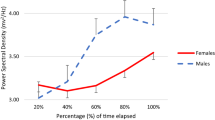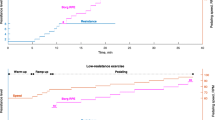Abstract
Background
The central governor model putatively explains the mechanism of endurance exercise-induced central fatigue, however high-intensity exercise-induced central fatigue strategies have not been investigated yet. This study aimed to examine how central fatigue affects neural response alterations, as measured by electroencephalographic (EEG) recordings, in intermittent high-intensity cycling.
Methods
Neural responses were assessed by measuring the alteration of brainwaves based on spectral energy band estimates during an intermittent, high-intensity, 60-min exercise bout on a cycle ergometer. The cycle ergometer incline was changed every 10 min in an intermittent pattern (10-20-5-20-5-10°). EEG was used to analyze altering brain function. Heart rate (HR), blood lactate (BL), and rating of perceived exertion (RPE) were measured after the participants completed each change in incline.
Results
The results showed that HR, BL, and RPE increased at an incline of 20° in comparison to a 5° incline. The spectral power of EEG was significantly increased (P ˂ 0.01) in the alpha and beta frequency ranges with a change in inclines between 5 and 20°. The spectral power of the EEG was significantly increased (P ˂ 0.01) over the whole frequency range from rest (theta + 251%, alpha + 165%, beta + 145%).
Conclusion
Higher, relative intensities (10 and 20°) increased brain function, regardless of fatigue occurrence. HIIT (high-intensity interval training) led to an alteration in the neural response. Further work investigating the usefulness of HIIT to improve brain function is warranted.




Similar content being viewed by others
Change history
25 January 2024
This article has been retracted. Please see the Retraction Notice for more detail: https://doi.org/10.1007/s10072-024-07337-7
References
Amann M (2011) Central and peripheral fatigue: interaction during cycling exercise in humans. Med Sci Sports Exerc 43(11):2039–2045. https://doi.org/10.1249/MSS.0b013e31821f59ab
Assenza G (2015) A useful electroencephalography (EEG) marker of brain plasticity: delta waves. Neural Regen Res 10(8):1673–5374. https://doi.org/10.4103/1673-5374.162698
Bailey S, Hall E, Folger S, Miller P (2008) Changes in EEG during graded exercise on a recumbent cycle ergometer. J Sports Sci Med 7(4):505–511. https://doi.org/10.1097/00005768-200405001-01373
Borg G (1998) Borg’s perceived exertion and pain scales. Champaign. IL, US: Champaign
Brümmer V, Schneider S, Strüder H, Askew C (2011) Primary motor cortex activity is elevated with incremental exercise intensity. Neuroscience 181(1):2011–2162. https://doi.org/10.1016/j.neuroscience.2011.02.006
Budde H, Wegner M, Soya H, Rehage C, McMorris T (2016) Neuroscience of exercise: neuroplasticity and its behavioral consequences. Neural Plast 3(1):1–3. https://doi.org/10.1155/2016/3643879
CE, E., Rampichini, S., & Veicsteinas, A. (2009) Effects of tiredness on visuospatial attention processes in élite karate athletes and non-athletes. Physiology 147:1–10
Cheron G (2015) From biomechanics to sport psychology: the current oscillatory approach. Psychology 6:1–6. https://doi.org/10.3389/fpsyg.2015.01642
Chun Kao S, Westfall D, Soneson J, Gurd B, Hillman C (2017) Comparison of the acute effects of high-intensity interval training and continuous aerobic walking on inhibitory control. Psychophysiology 54(9):1335–1345. https://doi.org/10.1111/psyp.12889
Coetsee C, Terblanche E (2017) The effect of three different exercise training modalities on cognitive and physical function in a healthy older population. Eur Rev Aging Phys Act 14(13):1–10. https://doi.org/10.1186/s11556-017-0183-5
Comani S, di Fronso S, Filho E, Castronovo M, Schmid M, Bortoli L, Bertollo M (2013) Attentional focus and functional connectivity in cycling: an EEG case study. Springer 41(1):137–140. https://doi.org/10.1007/978-3-319-00846-2_34
Del Percio C, Babiloni C, Infarinato F, Marzano N, Iacoboni M, Lizio R et al (2009) Effects of tiredness on visuo-spatial attention processes in élite karate athletes and non-athletes. Arch Ital Biol 147(1–2):1–10
DeLisi M (2014) Chapter 10: low self-control is a brain-based disorder. SAGE Publications Ltd. https://doi.org/10.4135/9781483349114
Enoka R, Stuart D (1992) Neurobiology of muscle fatigue. J Appl Physiol 72(5):1631–1648. https://doi.org/10.1152/jappl.1992.72.5.1631
Faria E, Parker D, Faria I (2005) The science of cycling: factors affecting performance - part 2. Sports Med 35(4):313–337. https://doi.org/10.2165/00007256-200535040-00003
Faria E, Parker D, Faria I (2005) The science of cycling: physiology and training - part 1. Sports Med 35(4):285–312. https://doi.org/10.2165/00007256-200535040-00002
Ghorbani M, Ghazalian F, Ebrahim Kh, Abednatanzi H (2019) Altered Neural Response Induced by Central-Fatigue in the Cortical Area During High-Intensity Interval Pedaling. Basic and Clinical Neuroscience 10(6): 631–639. https://doi.org/10.32598/BCN.9.10.440
Gandevia S (2001) Spinal and supraspinal factors in human muscle fatigue. Physiol Rev 81(4):1725–1789. https://doi.org/10.1152/physrev.2001.81.4.1725
Giboin L, Amiri E, Bertschinger R, Gruber M (2018) Active recovery affects the recovery of the corticospinal system but not of muscle contractile properties. PLoS One 13(5):1–16. https://doi.org/10.1371/journal.pone.0197339
Gotshall R, Bauer T, Fahrner S (1996) Cycling cadence alters exercise hemodynamics. Int J Sports Med 17(1):17–21. https://doi.org/10.1055/s-2007-972802
Gronwald T, Hoos O, Ludyga S, Hottenrottd K (2018) Non-linear dynamics of heart rate variability during incremental cycling exercise. Research in Sports Medicine 27:1–11. https://doi.org/10.1080/15438627.2018.1502182
Gruet M, Temesi J, Rupp T, Levy P, Verges S, Millet G (2014) Dynamics of corticospinal changes during and after high-intensity quadriceps exercise. Exp Physiol 99(8):1053–1064. https://doi.org/10.1113/expphysiol.2014.078840
Hagberg J, Mullin J, Giese M, Spitznagel E (1981) Effect of pedaling rate on submaximal exercise responses of competitive cyclists. J Appl Physiol Respir Environ Exerc Physiol 51(2):447–451. https://doi.org/10.1152/jappl.1981.51.2.447
Inzlicht M, Marcora S (2016) The central governor model of exercise regulation teaches us precious little about the nature of mental fatigue and self-control failure. Front Psychol 1(1):1–12. https://doi.org/10.3389/fpsyg.2016.00656
Jung, T., Makeig, S., Bell, A., & Sejnowski, T. (1998). Independent component analysis of electroencephalographic and event-related potential data. Central auditory processing and neural modeling. Springer, 189-97
Klem G, Lüders H, Jasper H, Elger C (1999) The ten-twenty electrode system of the international federation. The International Federation of Clinical Neurophysiology. Electroencephalogr Clin Neurophysiol Suppl 52(1):3–6
Kluger B, Krupp L, Enoka R (2013) Fatigue and fatigability in neurologic illnesses: proposal for a unified taxonomy. Neurology 80(4):409–416. https://doi.org/10.1212/WNL.0b013e31827f07be
Kong Z, Fan X, Sun S, Song L, Shi Q, Nie J (2016) Comparison of high-intensity interval training and moderate-to-vigorous continuous training for cardiometabolic health and exercise enjoyment in obese young women: a randomized controlled trial. PLoS One 11(7):1–16. https://doi.org/10.1371/journal.pone.0158589
Lin T, Chen C, Lin M (2018) Enzyme-free amperometric method for rapid determination of histamine by using surface oxide regeneration behavior of copper electrode. Sensors Actuators B Chem 255(3):2838–2843. https://doi.org/10.1016/j.snb.2017.09.101
Ludyga S, Gronwald T, Hottenrott K (2016) The athlete’s brain: cross-sectional evidence for neural efficiency during cycling exercise. Neural Plasticity 7(1):1–7. https://doi.org/10.1155/2016/4583674
Ludyga S, Hottenrott K, Gronwald T (2016) Four weeks of high cadence training alter brain cortical activity in cyclists. J Sports Sci 35(14):1–7. https://doi.org/10.1080/02640414.2016.1198045
Ludyga S, Gronwald T, Hottenrott K (2015) Do male and female cyclists’ cortical activity differ before and during cycling exercise? Journal of Sport and Exercise Psychology 37(6):617–625. https://doi.org/10.1123/jsep.2015-0078
Luo L, Li C, Deng Y, Wang Y, Meng P, Wang Q (2019) High-intensity interval training on neuroplasticity, balance between brain-derived Neurotrophic factor and precursor brain-derived neurotrophic factor in poststroke depression rats. J Stroke Cerebrovasc Dis 28(3):672–682. https://doi.org/10.1016/j.jstrokecerebrovasdis.2018.11.009
Mann T, Lamberts R, Lambert M (2013) Methods of prescribing relative exercise intensity: physiological and practical considerations. Sports Med 43(7):613–625. https://doi.org/10.1007/s40279-013-0045-x
Noakes T (2011) Time to move beyond a brainless exercise physiology: the evidence for complex regulation of human exercise performance. Appl Physiol Nutr Metab 36(1):23–35. https://doi.org/10.1139/H10-082
Noakes T (2012) Fatigue is a brain-derived emotion that regulates the exercise behavior to ensure the protection of whole body homeostasis. Front Physiol 3(82):1–13. https://doi.org/10.3389/fphys.2012.00082
Noakes T (1997) Wolffe Memorial Lecture. Challenging beliefs: Ex Africa Semper a liquid Novi. Med Sci Sports Exerc 29(5):571–590
Noakes T (2000) Physiological models to understand exercise fatigue and the adaptations that predict or enhance athletic performance. Scand J Med Sci Sports 10(3):123–145
Noakes T (2011) Is it time to retire the A.V. Hill Model? Sports Med 41(4):263–277. https://doi.org/10.2165/11583950-000000000-00000
Noakes T, Peltonen J, Rusko H (2001) Evidence that a central governor regulates exercise performance during acute hypoxia and hyperoxia. J Exp Biol 204(18):3225–3234
Noakes TD, St Clair Gibson A, Lambert EV (2005) From catastrophe to complexity: a novel model of integrative central neural regulation of effort and fatigue during exercise in humans: summary and conclusions. Br J Sports Med 39(2):120–124. https://doi.org/10.1136/bjsm.2003.010330
Nobrega A, O'Leary D, Silva B, Marongiu E, Piepoli M, Crisafulli A (2014) Neural regulation of cardiovascular response to exercise: role of central command and peripheral afferents. Biomed Res Int 2014:1–20. https://doi.org/10.1155/2014/478965
Rattray B, Argus C, Martin K, Northey J, Driller M (2015) Is it time to turn our attention toward central mechanisms for post-exertional recovery strategies and performance? Front Physiol 6(79):1–14. https://doi.org/10.3389/fphys.2015.00079
Samuel R, Zavdy O, Levav M, Reuveny R, Katz U, Dubnov-Raz G (2017) The effects of maximal intensity exercise on cognitive performance in children. J Hum Kinet 57(1):85–96. https://doi.org/10.1515/hukin-2017-0050
Skorski S, Abbiss C (2017) The manipulation of pace within endurance sport. Front Physiol 8(1):102–110. https://doi.org/10.3389/fphys.2017.00102
Taylor J, Gandevia S (2008) A comparison of central aspects of fatigue in submaximal and maximal voluntary contractions. J Appl Physiol 104(2):542–550. https://doi.org/10.1152/japplphysiol.01053.2007
Taylor, J., Amann, M., Duchateau, J., Meeusen, R., & Rice, C. (2016). Neural contributions to muscle fatigue: from the brain to the muscle and back again. Medicine and science in sports and exercise. 48(11), 2294–2306. DOI:https://doi.org/10.1249/MSS.0000000000000923
Weavil J, Sidhu S, Mangum T, Richardson R, Amann M (2016) Fatigue diminishes motoneuronal excitability during cycling exercise. J Neurophysiol:1743–1751. https://doi.org/10.1152/jn.00300.2016
Tanaka H, Bassett DR Jr, Swenson T, Sampedro M (1993) Aerobic and anaerobic power characteristics of competitive cyclists in the United States Cycling Federation. Int J Sports Med 14(6):334–338
Author information
Authors and Affiliations
Corresponding author
Ethics declarations
The ethics committee of the Medical Faculty of the Azad University of Science and Research Branch of Tehran confirmed this study by the number of IR.IAU.PS.REC. 1397-115, and all aspects of this study were performed in accordance with the Declaration of Helsinki.
Ethical considerations
All procedures were in accordance with the ethical of Helsinki declaration and with ethical committee approval of the Medical Faculty of Azad University of Science and Research Branch, Tehran (1397-115).
Conflict of interest
None
Ethical approval
IR.IAU.SRB.REC.1397.115
Informed consent
IR.IAU.SRB.REC.1397.115
Additional information
Publisher’s note
Springer Nature remains neutral with regard to jurisdictional claims in published maps and institutional affiliations.
This article has been retracted. Please see the retraction notice for more detail: https://doi.org/10.1007/s10072-024-07337-7"
Rights and permissions
Springer Nature or its licensor (e.g. a society or other partner) holds exclusive rights to this article under a publishing agreement with the author(s) or other rightsholder(s); author self-archiving of the accepted manuscript version of this article is solely governed by the terms of such publishing agreement and applicable law.
About this article
Cite this article
Ghorbani, M., Clark, C.C.T. RETRACTED ARTICLE: Brain function during central fatigue induced by intermittent high-intensity cycling. Neurol Sci 42, 3655–3661 (2021). https://doi.org/10.1007/s10072-020-04965-7
Received:
Accepted:
Published:
Issue Date:
DOI: https://doi.org/10.1007/s10072-020-04965-7




